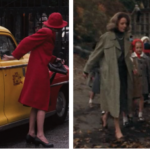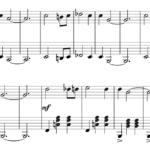“I’m With You Now”: Michael Corleone’s Journey to Become His Father’s Son
By Nikki Munoz
The title of The Godfather is a surprisingly cunning one: ultimately it turns out to refer not to Marlon Brando’s Vito Corleone, but rather to his son, Michael, portrayed by Al Pacino. It is Michael who comes to sit at the core of this film — Michael, whose character is its focus. Viewers watch as Michael evolves from the outsider of the family — the one with higher morals who keeps his distance; the war hero—to a character distinctly like his father, the family patriarch and Don of this crime world.
Within the arc of any dynamic character, the instances of change are often subtle and dispersed throughout the narrative. Yet sometimes there is a decisive moment — a moment when a character chooses a new path. For Michael Corleone, this pivotal moment falls about an hour into the three-hour film, when he goes to visit his father in the hospital and declares quietly to him, “I’m with you now.” Through the intricate interweaving of details that allude to this character’s before and after, as well as meticulous shots that depict a transfer of power, the film develops this scene as the exact moment when Michael transfers his allegiance fully into his father’s world.
***
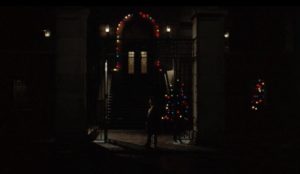
The scene begins with a shot of the outside of the hospital, though the building is not easily recognizable as one — the first of several subtle, almost surrealist elements that impart a feeling of isolation and strangeness to the scene. The building is overcome by darkness, only vaguely lit up by a sparse amount of Christmas lights hanging above the door, and a small Christmas tree with lights by the gated entrance. There appears to be a second tree even farther right, creating the feeling of a tilt. After being dropped off, Michael stands in front of the gate, hardly visible through the darkness, and looks after the car that has quickly driven off. His hesitation before climbing the stairs and entering the hospital is explicit. The uneven lights, clearly denser on the right, lean to the side that Michael is not looking toward, but indicate the directional path he will be following as the plot moves forward. As he looks into the darkness, a disconnect is clear. It is the last moment before Michael crosses an important threshold and, here, he appears as if he is taking one last look at his previous life.
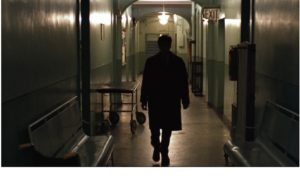
The darkness of this shot then cuts to an only slightly brighter shot of an empty hallway. Michael soon fills that emptiness, becoming, seemingly, the only person filling an empty hospital. What follows Michael’s entrance to the empty hallway is a long buildup to him finally finding his father’s hospital room. It takes almost exactly one minute of Michael traveling through the hospital’s consistently empty rooms before he reaches what he set out for. This minute feels much longer than the mere sixty seconds, however, as Michael roams through a seemingly endless maze-like path of empty hallways. The emptiness is eerie, and never addressed nor explained — not even by Michael himself — and we as viewers sense that we’ve been enclosed in a surreal world, a world with an altered atmosphere.
Michael in this hospital is almost outside of the realm of the rest of the plot and there is a sense of the viewer being let in on a very intimate moment for Michael— the emptiness being a key element to this. Throughout this prolonged search, Michael’s singularity is emphasized. As the sole moving figure of an empty hallway, all focus is on him, just as the film’s entire plot molds itself around this character. This scene becomes about Michael looking for his father, rather than the fate of Vito himself.
The long journey through hallways eventually leads Michael to his father’s hospital room, at the end of yet another hallway. Michael, who had been running, slows down his pace and takes his time walking down this hallway. He then turns into the crevice at the hallway’s end, and from the viewer’s perspective, it looks like he has entered the room. Yet the next shot reveals that he is still outside of the closed door, pausing before opening it.
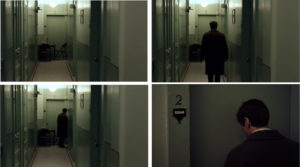
The viewer sees him linger outside of room 2, an interesting room number, considering how long it took him to find it — quite low for being so deep inside of the hospital, adding another layer of surrealism. Michael’s pause here is not the first, as we have already seen him hesitate outside of the hospital. His initial slow pace through the hallways is related, indicating an overall feeling of not needing — or wanting — to rush. He has not yet seen his father, meaning his life has not shifted — not yet. This lingering and hesitating does not occur after he has seen his father, only before — which means that this moment of him in front of room 2 is the last instance of it.
Once entering his father’s room, the focus remains on Michael, as viewers are only given a limited perspective of Vito in the hospital bed. Now in the room, the changes within Michael start to become outwardly apparent. The presence of another person, besides him and his father — the nurse — indicates that he now has to enact the role he is stepping into. And he does, in the form of giving orders. Michael says, “Nurse. Wait a minute. Stay here.” And while the nurse has no reason to be listening to Michael, someone she has just informed is not even supposed to be there, she does anyway. He asks her to move his father’s bed — and, again, there is no reason for the nurse to do as Michael says, but she does. Michael has begun to grasp the elements of a leadership role. With the giving of these orders, he saves his father, the man who was previously the self-possessed family patriarch.
After moving his father’s hospital bed into a different room, Michael leans over his recovering father—and we as viewers see him shift before our eyes. The use of physicality to display the power dynamics here is vital. Vito is unmoving — he is physically restrained and cannot move; viewers have just seen this emphasized, as his motionless body was pushed through the hallway by Michael and the nurse. By contrast, Michael has just demonstrated his adept mobility to the audience, as he scoured the hospital for his father and, further, pushed around Vito’s bed. Throughout this moment between them, Michael is leaning over his father the entire time, always at a much higher level. The uneven level of power is not used negatively here, as Michael and Vito share a compassionate moment as father and son. The key detail, however, is that this is a decision made by Michael. Michael has the power to lead what happens here; he is wholly in charge. Michael is in this hospital room willingly, unlike Vito. He even gives his father an order, in the form of “Just lie here, Pop.” It is said quietly and soothingly, but it is an order nonetheless.
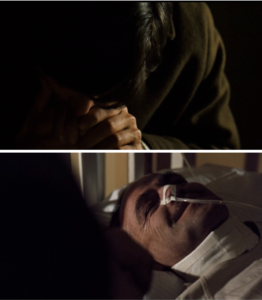
Michael then utters the sentence to his father that signals his turning point: “I’m with you now.” This sentence indicates that Michael was not with his father beforehand — and indeed he wasn’t; he was distant from his family and its operations.
Further, he is verbally committing himself to the family; this sentence acts as a kind of oath. Then, there is slight repetition when he says again, “I’m with you,” which solidifies his stance more firmly. Vito does not verbally respond, but gives a clear smile, as you can see a small tear coming from his eye. With their hands grasping each other’s and Michael looking down upon the current patriarch, this moment also acts as a kind of transition of power. The smile can also be seen as an approval — the go ahead for Michael to move forward in his path toward becoming The Godfather. While subtle and intimate, this moment holds a great amount of significance, rippling beyond the two people experiencing it.
After this key moment, the film cuts to Michael exiting the hospital: a quick, five seconds of him walking through the hallway before cutting to him outside of the hospital. His five-second exit is in stark contrast to his previous minute-long odyssey through those same hospital hallways: the transfer of power has been completed and there is no longer a pivotal moment to build up to. Michael is coming out of the hospital a different person; the brevity of this exit conveys a man who knows where he is going.
It is just five seconds, yet with a distant and serious look on his face and a quick pace, the difference in Michael is clear. He resembles the person we imagine Vito to have been in his heyday—the purposeful head of the Corleone family—more than the person he was when he stepped into the hospital. He is now well on his way to becoming the Godfather.


